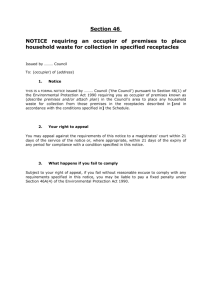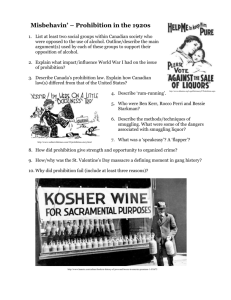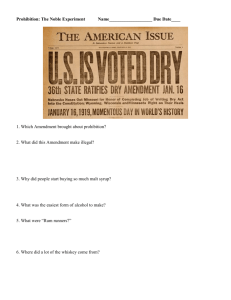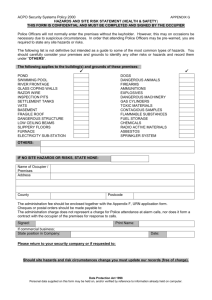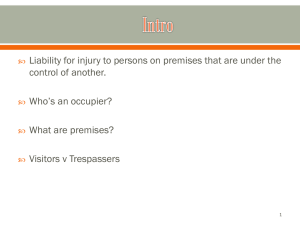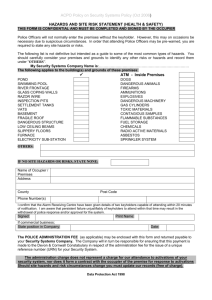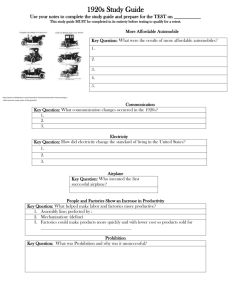Prohibition Order – Regulated systems
advertisement
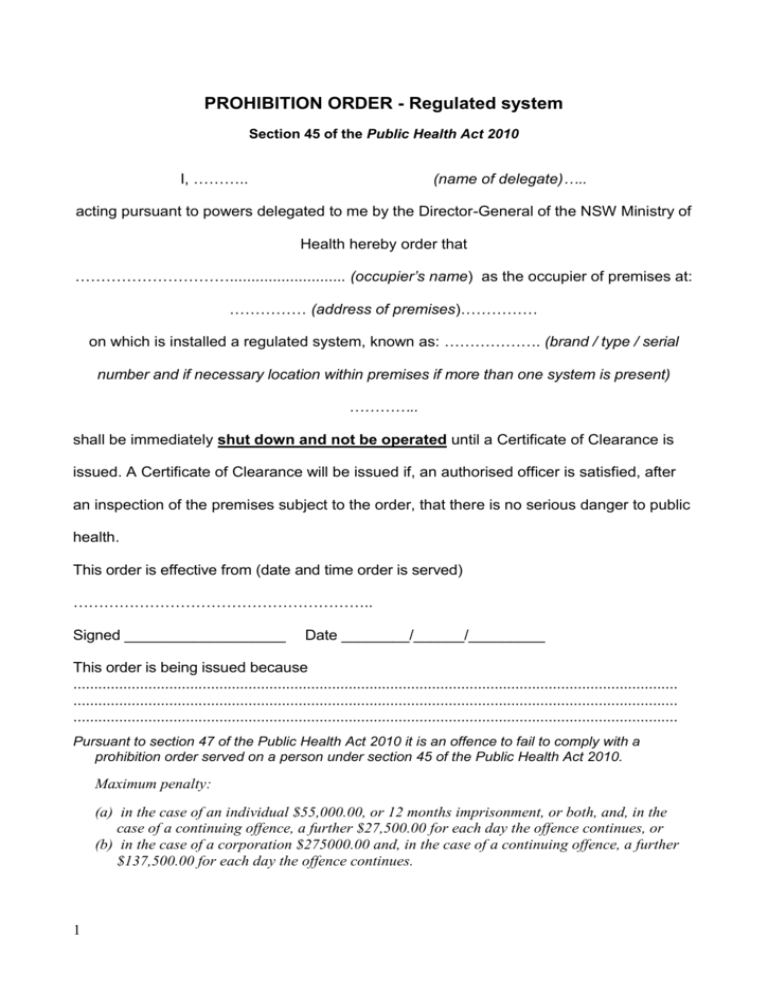
PROHIBITION ORDER - Regulated system Section 45 of the Public Health Act 2010 I, ……….. (name of delegate)….. acting pursuant to powers delegated to me by the Director-General of the NSW Ministry of Health hereby order that …………………………........................... (occupier’s name) as the occupier of premises at: …………… (address of premises)…………… on which is installed a regulated system, known as: ………………. (brand / type / serial number and if necessary location within premises if more than one system is present) ………….. shall be immediately shut down and not be operated until a Certificate of Clearance is issued. A Certificate of Clearance will be issued if, an authorised officer is satisfied, after an inspection of the premises subject to the order, that there is no serious danger to public health. This order is effective from (date and time order is served) ………………………………………………….. Signed ___________________ Date ________/______/_________ This order is being issued because ................................................................................................................................................. ................................................................................................................................................. ................................................................................................................................................. Pursuant to section 47 of the Public Health Act 2010 it is an offence to fail to comply with a prohibition order served on a person under section 45 of the Public Health Act 2010. Maximum penalty: (a) in the case of an individual $55,000.00, or 12 months imprisonment, or both, and, in the case of a continuing offence, a further $27,500.00 for each day the offence continues, or (b) in the case of a corporation $275000.00 and, in the case of a continuing offence, a further $137,500.00 for each day the offence continues. 1 Prescribed Fee payable In accordance with clause 97 of the Public Health Regulation 2012, a prescribed fee of....................................... is payable on this prohibition order in relation to the Regulated System. The prescribed fee must be paid to the relevant agency within 60 days after the notice is given. Application may be made to the relevant agency for an extension of time to pay the fee or for a part or whole waiver of the fee. Failure to pay any outstanding fee within the required period, or after an extension period allowed by the relevant agency, is an offence under clause 97 of the Public Health Regulation 2012. An invoice will be issued for payment. The relevant agency for this prohibition notice is: 1) The Director General of the Ministry of Health, or 2) .......................................................................Local Government Authority, or 3) ........................................................................Council 4) Note: A Clearance Certificate can only be issued if, after an inspection of the premises subject to the order, an Authorised Officer is satisfied that there is no serious danger to public health. The Occupier may, at any time after the prohibition order has been served, make a written request to the Director-General or a delegate to cause the premises to be inspected by an Authorised Officer. If a request for inspection is made and, through no fault of the Occupier who made the request, the inspection does not take place within 2 working days of the request being received by the DirectorGeneral or delegate, a Clearance Certificate is taken to have been given. You are advised that under the provisions of section 48 of the Public Health Act 2010 you may apply to the Administrative Decisions Tribunal for a review of a decision not to issue a clearance certificate. If you contravene or fail to comply with this Prohibition Order the maximum penalty is: (a) in the case of an individual—500 penalty units, or 12 months imprisonment, or both, and, in the case of a continuing offence, a further 250 penalty units for each day the offence continues, or (b) in the case of a corporation—2,500 penalty units and, in the case of a continuing offence, a further 1,250 penalty units for each day the offence continues. If you require any further information in this matter please contact ...................................................(Officer) on.....................................(telephone number) Delegate of the Director-General of the Ministry of Health Dated: 2 Information on Prohibition Orders and Requirements for Regulated Systems Public Health Act 2010 Part 3, Division 5: Improvement notices and prohibition orders 40 Definitions In this Division: enforceable requirement means: (a) a prescribed installation requirement, prescribed maintenance requirement or prescribed operating requirement with respect to a regulated system under Division 2, or (b) a prescribed operating requirement with respect to a public swimming pool or spa pool under Division 3, or (c) a requirement prescribed with respect to premises at which skin penetration procedures are carried out under section 38. public swimming pool or spa pool has the same meaning as it has in Division 3. 41 Non-complying premises or procedures An authorised officer may serve an improvement notice on the occupier of premises at which there is a regulated system or a public swimming pool or spa pool or premises at which a person carries out skin penetration procedures if the officer believes, on reasonable grounds, that: (a) the premises, or a regulated system, public swimming pool or spa pool at those premises, does not comply with an enforceable requirement, or (b) a regulated system, public swimming pool or spa pool at the premises is not being maintained or operated in accordance with an enforceable requirement. 42 Improvement notices (1) An improvement notice is to take the form of a direction that requires a specified enforceable requirement to be complied with within a period of 72 hours (or such longer period as is specified in the notice) after the service of the notice on the occupier or person. (2) The notice may specify the actions to be taken to comply with the requirement. (3) An improvement notice is to state that it is issued under this section and to specify any provision of the regulations to which it relates. 43 Compliance with improvement notice (1) If an improvement notice is complied with, an authorised officer is to note the date of compliance on the notice. (2) An authorised officer must give a copy of an improvement notice, noted in accordance with this section, to the person on whom the improvement notice was served if requested to do so by the person. 44 Failure to comply with notice relating to regulated system (1) The Director-General, a local government authority or the General Manager of a council may take action under this section or section 45 if the occupier of premises at which there is a regulated system fails to comply with an improvement notice. (2) The Director-General, local government authority or General Manager may take the action 3 Information on Prohibition Orders and Requirements for Regulated Systems referred to in the notice and: (a) unless the occupier represents the Crown, may recover an amount equal to the cost of doing so as a debt owed by the person to the Crown or to the local government authority, as the case may be, or (b) if the occupier represents the Crown, may require the occupier to pay to the DirectorGeneral or to the local government authority an amount equal to the cost of doing so. (3) An employee assigned, or a contractor engaged, by the Director-General or a local government authority to do any work on regulated premises under this section may, at any reasonable time, enter the premises and do the work or have it done. 45 Prohibition order (1) The Director-General, a local government authority or a General Manager of a council may serve a prohibition order on the occupier of premises if the Director-General, authority or General Manager believes on reasonable grounds: (a) that any of the circumstances in which an improvement notice may be issued exist and that: (i) the occupier has not complied with an improvement notice within the time required under the notice, and (ii) the issue of the prohibition order is necessary to prevent or mitigate a serious risk to public health, or (b) that any of the circumstances in which an improvement notice may be issued exist and that the issue of the order (without first issuing an improvement notice) is urgently necessary to prevent or mitigate a serious risk to public health. (2) A prohibition order made against the occupier of premises at which there is a regulated system is to take the form of an order that the system must not be operated until the occupier has been given a clearance certificate stating that the system may be operated. (3) A prohibition order made against the occupier of premises at which there is a public swimming pool or spa pool is to take the form of an order that the swimming pool or spa pool must not be opened for use by the public until the occupier has been given a clearance certificate stating that the swimming pool or spa pool may be opened for use by the public. (4) A prohibition order made against the occupier of premises at which skin penetration procedures are carried out is to take the form of an order that such procedures must not be carried out at the premises until the occupier has been given a clearance certificate stating that skin penetration procedures may be carried out at the premises. (5) A prohibition order is to state that it is issued under this section and to specify any provision of the regulations to which it relates. (6) The Director-General, local government authority or General Manager who made the prohibition order must give a certificate of clearance if, after an inspection of the premises subject to the order, an authorised officer is satisfied that there is no serious danger to public health. 46 Request for re-inspection (1) An occupier of premises who is subject to a prohibition order may at any time after the order has been served make a written request to the person who made the order to cause the premises to be inspected by an authorised officer. (2) If a request for inspection is made under this section and, through no fault of the person who made the request, the inspection does not take place within 2 working days of the request being received by the person who made the prohibition order, a certificate of clearance is taken to have been given under this Division to the person who made the request. 4 Information on Prohibition Orders and Requirements for Regulated Systems 47 Contravention of prohibition order A person must not fail to comply with a prohibition order served on the person under this Part. Maximum penalty (for an offence in respect of a public swimming pool or spa pool or premises where skin penetration procedures are carried out): (a) in the case of an individual—200 penalty units, or 12 months imprisonment, or both, and, in the case of a continuing offence, a further 100 penalty units for each day the offence continues, or (b) in the case of a corporation—1,000 penalty units and, in the case of a continuing offence, a further 500 penalty units for each day the offence continues. Maximum penalty (for an offence in respect of a regulated system): (a) in the case of an individual—500 penalty units, or 12 months imprisonment, or both, and, in the case of a continuing offence, a further 250 penalty units for each day the offence continues, or (b) in the case of a corporation—2,500 penalty units and, in the case of a continuing offence, a further 1,250 penalty units for each day the offence continues. 48 Review of decision to refuse certificate of clearance An occupier of premises on whom a prohibition order has been served may apply to the Administrative Decisions Tribunal for a review of a decision of the person who made the order to refuse to give a certificate of clearance under this Part to the occupier. 49 Compensation (1) A person against whom a prohibition order is made who suffers loss as a result of the making of the order may apply to the person who made the order for compensation if the person against whom the order is made considers that the order was not made in good faith or that there were no grounds for the making of the order. (2) If the order was not made in good faith or there were no grounds for the making of the order, the Director-General, the local government authority or the council (if the order was issued by the General Manager of the council) is to pay such compensation to the applicant as is just and reasonable. (3) The person who made the prohibition order is to determine the compensation payable in accordance with subsection (2). (4) The person who made the prohibition order is to send written notification of its determination as to the payment of compensation under this section to each applicant for the payment of such compensation. (5) If an application for compensation under this section is not determined by the person who made the prohibition order within 28 days of receiving the application, the application is taken to have been refused. (6) An applicant for the payment of compensation under this section who is dissatisfied with a determination as to the refusal to pay compensation or as to the amount of compensation may apply to the Administrative Decisions Tribunal for a review of the determination: (a) within 28 days after the day on which notification of the determination was received, or (b) in a case to which subsection (5) applies, within 28 days after the expiration of the 28-day period referred to in that subsection. ...................................................................................................................................................... Public Health Regulation 2012: 5 Information on Prohibition Orders and Requirements for Regulated Systems 97 Fee for improvement notices and prohibition orders (1) A person who is given an improvement notice or a prohibition order must, within 60 days after the notice is given, pay the prescribed fee to the relevant agency if the notice or order contains a requirement to do so. (2) The relevant agency may: (a) extend the time for payment of the fee, on the application of the person to whom the improvement notice or prohibition order was given, or (b) waive payment of the whole or any part of the fee, on the relevant agency’s own initiative or on the application of the person to whom the improvement notice or prohibition order was given. (3) A person to whom an improvement notice or prohibition order is given must pay the fee required by this clause within the time provided under this clause. Maximum penalty: 20 penalty units. The prescribed fee is, in the case of a prohibition order given to an occupier of premises at which there is a regulated system is: (i) before 1 July 2013—$500, and (ii) on or after 1 July 2013 and before 1 July 2014—$515, and (iii) on or after 1 July 2014 and before 1 July 2015—$530, and (iv) on or after 1 July 2015 and before 1 July 2016—$545, and (v) on or after 1 July 2016—$560, The relevant agency is: (a) in the case of an prohibition order given by an authorised officer appointed by the Director-General of the Ministry of Health—the Director-General of the Ministry of Health, or (b) in the case of an prohibition order given by an authorised officer appointed by a local government authority or a prohibition order given by a local government authority—the local government authority, or (c) in the case of a prohibition order given by a General Manager of a council—the council. Prescribed Requirements - Public Health Regulation 2012 6 Prescribed installation requirements (1) For the purposes of Division 2 of Part 3 of the Act, the prescribed installation requirements are the requirements set out in this clause. (2) Air-handling systems, hot-water systems, warm-water systems and water-cooling systems must be installed in accordance with AS/NZS 3666.1:2011 Air-handling and water systems of buildings—Microbial control—Design, installation and commissioning, as applicable to the specific system. (3) An air-handling system must be fitted with supply air filters. (4) A warm-water system must not be installed in a hospital unless it is of a kind approved in writing by the Director-General. An application for an approval by the Director-General is to be accompanied by a fee of $160. 7 Prescribed operating requirements 6 Information on Prohibition Orders and Requirements for Regulated Systems (1) For the purposes of Division 2 of Part 3 of the Act, the prescribed operating requirements are the requirements set out in this clause. (2) A regulated system must be operated as required by AS/NZS 3666.2:2011 Air-handling and water systems of buildings—Microbial control—Operation and maintenance. (3) There must be safe and easy access to a regulated system for the purpose of the cleaning, inspection and maintenance of the system. (4) A water-cooling system must be equipped with a disinfection procedure that is in operation at all times and that is designed to control microbial growth so that: (a) the level of Legionella in the system is not more than 10 colony-forming units per millilitre, and (b) the heterotrophic plate count in the system is not more than 100,000 colony-forming units per millilitre. (5) If a level set out in subclause (4) (a) or (b) is exceeded, remedial action must be taken as soon as practicable by a competent person or a person acting under the supervision of a competent person. 8 Prescribed maintenance requirements (1) For the purposes of Division 2 of Part 3 of the Act, the prescribed maintenance requirements are the requirements set out in this clause. (2) A regulated system (other than a water-cooling system) must be maintained in accordance with AS/NZS 3666.2:2011 Air-handling and water systems of buildings—Microbial control—Operation and maintenance. (3) A water-cooling system must be maintained in accordance with: (a) AS/NZS 3666.2:2011 Air-handling and water systems of buildings—Microbial control— Operation and maintenance, or (b) AS/NZS 3666.3:2011 Air-handling and water systems of buildings—Microbial control— Performance-based maintenance of cooling water systems but only if the occupier of the premises on which the water-cooling system is installed has notified the local government authority for the area. (4) For the purposes of subclause (3) (b), a reference in AS/NZS 3666.3:2011 Air-handling and water systems of buildings—Microbial control—Performance-based maintenance of cooling water systems to a person competent to evaluate the condition of a cooling water system is a reference to a competent person or a person acting under the supervision of a competent person. (5) All tests carried out in the course of complying with the prescribed maintenance requirements for a regulated system must be carried out in a laboratory accredited by the National Association of Testing Authorities for that purpose. (6) Additional maintenance requirement for hot-water systems Maintenance must be carried out on a hot-water system to ensure that at any time when the system is in operation it delivers water at each outlet each time the outlet is turned on at not less than 60 degrees Celsius, once any water standing in the pipe to that outlet before it was turned on has been expelled. (7) Additional maintenance requirement for warm-water systems Maintenance carried out on a warm-water system must comply with the document entitled Requirements for the provision of cold and heated water published by the Ministry of Health. 7
